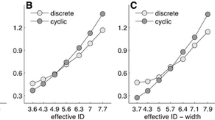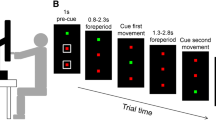Abstract.
The present study focuses on two trajectory-formation models of point-to-point aiming movements, viz., the minimum-jerk and the minimum torque-change model. To date, few studies on minimum-jerk and minimum torque-change trajectories have incorporated self- or externally imposed end-point constraints, such as the direction and velocity with which a target area is approached. To investigate which model accounts best for the effects on movement trajectories of such – in many circumstances – realistic end-point constraints, we adjusted both the minimum-jerk and the minimum torque-change model so that they could generate trajectories of which the final part has a specific direction and speed. The adjusted models yield realistic trajectories with a high curvature near movement completion. Comparison of simulated and measured movement trajectories show that pointing movements that are constrained with respect to final movement direction and speed can be described in terms of minimization of joint-torque changes.
Similar content being viewed by others
Author information
Authors and Affiliations
Additional information
Received: 7 July 1999 / Accepted in revised form: 8 January 2001
Rights and permissions
About this article
Cite this article
Klein Breteler, M., Gielen, S. & Meulenbroek, R. End-point constraints in aiming movements: effects of approach angle and speed. Biol Cybern 85, 65–75 (2001). https://doi.org/10.1007/PL00007997
Issue Date:
DOI: https://doi.org/10.1007/PL00007997




